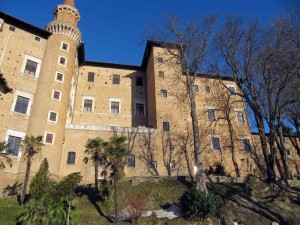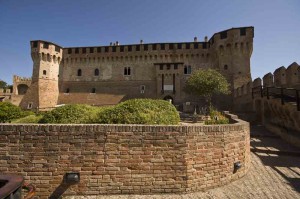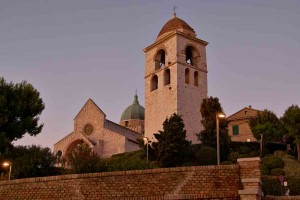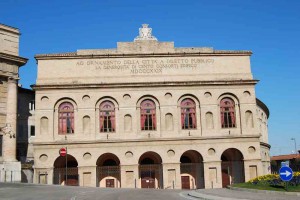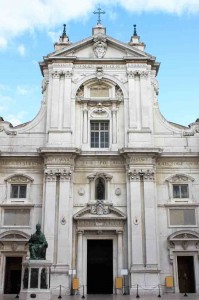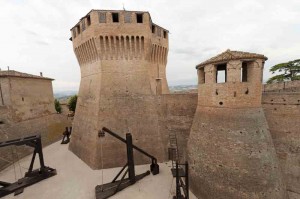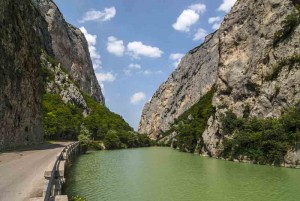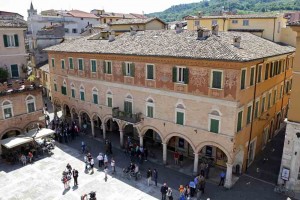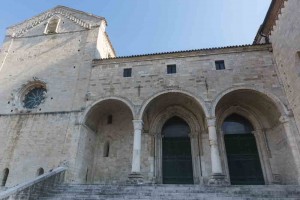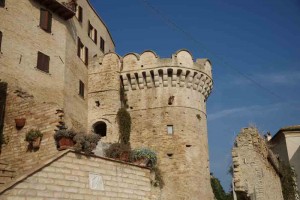Marche, nestled in-between the Adriatic Sea and the Apennines, spreads across nearly 9,700 km² and five provinces with the capital Ancona. The mix of attractive coastal strips, wavy hills and mountain ranges gives the scenery special character. It comes as no surprise that the various cities and spots of this region are just as diverse and varied. These top 10 sights in Marche by ZAINOO will definitely show you the way during your travels:
Palazzo Ducale in Urbino
In the second half of the 15th century, Duke Federico III da Montefeltro indented the construction of a new ducal palace in Urbino. The walls of the previous building were recycled and integrated into the new Renaissance structure of Palazzo Ducale. Federico da Montefeltro preferentially used this palace for humanistic and classic studies. The only 12 m² large studiolo with view of Urbino’s manors is lined with 28 portraits and several musical instruments. You must step in the national gallery to witness one of the most glorious Renaissance art collections in the world with pieces by Raphael and Titian.
Castello di Gradara
The village Gradara is located three kilometres inland from the Adriatic coast in the north-east-most part of Marche. It is home to a particularly grand castle that was once held by the Malatesta family, who were predominantly active in Emilia-Romagna. Two rings of walls protect the castello located on the hill with the outer ring alone being almost 800 metres long. One of the most imposing medieval structures, the centrally located fortification was the site of many disputes between the popes and the sovereigns of the adjacent regions.
Ancona Cathedral
A brief hike brings you up on the Guasco hill overlooking Ancona. Once you’ve made your way through the thick vegetation, the city cathedral is waiting for you. It was once the site of the acropolis of this city with a Greek touch. These days, Romanesque, Byzantine and Gothic elements collide in wondrous ways. If you want to enter the cathedral, you first need to get past the two lions made from red marble that guard the entrance to this building with recycled Roman pillars.
Sferisterio di Macerata
When the people of Macerata were looking for a venue for the erstwhile popular sport pallone col bracciale, an archetype of sorts of tennis and fistball in the broadest sense, the Sferisterio (deriving from “sphaeristerium”, a large area for ball exercises in Ancient Rome) was built. As pallone lost relevance, the floor was lifted and opened for tennis and football. These days, the Sferisterio is mainly the site of the town’s opera festival. If you want to witness a performance, you should try getting a seat in the middle of the auditorium, as the acoustics are best there.
Basilica of the Holy House in Loreto
Loreto is home to one of Italy’s most important pilgrimage churches. According to legend, this is where the Holy House, where angels announced the birth of Jesus Christ to Mary, is located. Angels carried it from Nazareth to Loreto after the crusaders had lost the Holy Land. It is now widely assumed that the house was brought to town by the mercantile family Angeli at the end of the 13th century. This richly decorated house with three walls was initially overbuilt with a small church that eventually moved into the present Renaissance basilica.
Rocca Roveresca in Mondavio
Francesco di Giorgio Martini wasn’t just a painter and a sculptor, he also worked as an architect and constructed several fortifications all over the duchy of Giovanni della Rovere, the son-in-law of Federico da Montefeltro, including the Rocca Roveresca in Mondavio. It is one of the masterpieces of military Renaissance architecture and still very well preserved as it never came to any attacks or sieges. Every side of this polygonal building can be perfectly defended via weaponry recesses. The museum exhibits scenes of Renaissance and military everyday life.
Furlo Pass
The old Roman Via Flaminia guides you through one of the most breathtaking gorges of the country. A 3 km long tunnel leads through the smallest point of the Furlo Pass. It was built in 76 AD under the Roman emperor Vespasian and stood the test of time – yet another example for extraordinary Roman architecture. Chisel traces can still be see in the craggy lime rocks. A long and winding road leads you to the summit of the gorge, where you can enjoy a picnic in dizzying heights while the river Candigliano rushes past.
Piazza del Popolo in Ascoli Piceno
Life in Ascoli Piceno happens around Piazza del Popolo (“Square of the People”). It was mainly constructed from grey travertine marble stemming from the surrounding mountains. Several charming buildings are waiting for you here including the 13th century seat of government Palazzo dei Capitani del Poplolo. The Gothic church San Francesco, built over the course of many centuries, is decorated with a monument dedicated to Pope Julius II. The adjacent Renaissance cloister is the site of the morning city market.
Concattedrale di Osimo
Osimo’s cathedral is dedicated to Saint Leopardus, who, according to lore, built it on pagan structures from Roman times in the 5th century. Saint Vitalian supposedly carried out extensive reconstructions in the 7th century. A stone tablet commemorates the former bishop. Relics of these two and other saints and of Osimo’s martyrs were placed inside the crypt. The wooden cross inside the cathedral dates back to the times of Bishop Gentile. Several witness claimed to have seen the crucified saviour move on 2 July 1797. An annual feast is now held on this very day.
Grottamare Borgo Antico
Among the most popular tourist attractions in Marche is Grottamare, located in the south-east-most part of the region. The area was already populated in the Stone Age and ruled by the Benedictines in the Middle Ages. The medieval town core once developed around Piazza Peretti, which is surrounded by the old town walls that were built to protect from perpetrators. A walk along these walls leads to the restored defence tower and past several glorious churches. It comes as no surprise that the town’s most famous son is Pope Sixtus V.
A round trip through Marche leads you through a varied land with a sheer mass of ecclesiastical and secularised buildings, breathtaking wonders of nature and historic sites. This selection of sights by ZAINOO guarantees the success of your holiday between the Adriatic Sea and the Apennines.
